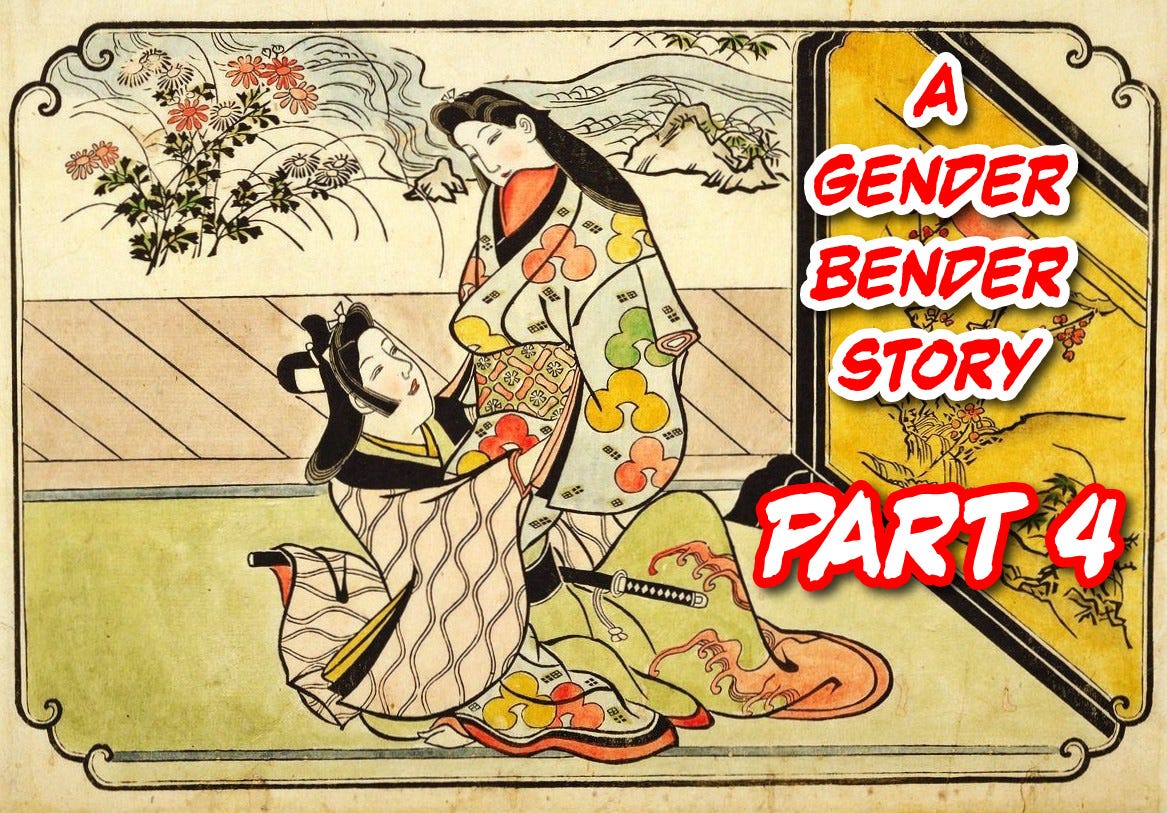Torikaebaya Monogatari: The Epic, Raunchy Gender Bending Story of Early Japan (Part 4)

Finally, the conclusion to our heartwarming story. If you haven’t read Part 3 yet, click here.
The last third of the book tries to wrap up all the loose ends by marrying everyone off and describing the various promotions and titles they receive throughout their lives.
The Crown Prince takes his turn at violating Himegimi, but then they marry so that’s all cool then... Himegimi becomes Empress (mystical prince was right!), and gives birth to the new Crown Prince.
Wakagimi “inherits” Himegimi’s marriage to Yon no Kimi, and also marries the older princess and the Imperial Princess.
You’d think Saishō’d get punished for his total fuckboyishness, but instead he gets to marry the younger princess. He does not stop bemoaning his cruel fate, of course, and never fully realizes Wakagimi and Himegimi swapped roles.
The end.
Yeah…if you thought this story was confusing, you ain’t seen the half of it. For the sake of my sanity and yours, I used Himegimi and Wakagimi throughout, but in the original Japanese, the characters have no names, there are no gendered pronouns, and everyone is referred to by their ranks and titles, which change several times during the course of the story.
After introducing Wakagimi and Himegimi and describing their childhood, seeing a delightful potential for making the reader stumble, the narrator gleefully declares: “Hereafter I shall refer to the children as the others had come mistakenly to do; the son I shall call the daughter, and the daughter the son.” When in the end the two characters swap roles, the two titles are simply swapped, and the reader is expected to keep track. The English translation at least gives an occasional “the former so-and-so,” but it’s still a confusing mess.
Torikaebaya was written at the end of the 1000s and revised some time in the 1100s. Only this later revision still exists, and we don’t know who the authors of either were.
As a modern reader, it’s hard to distinguish between comedy and tragedy. A lot of the plot feels like a Shakespearean comedy (e.g., Twelfth Night, with its gender swapping). Many of the narrator’s comments sound like snarky parody to us, but Torikaebaya was probably meant as a dramatic, moral tale.
It’s striking that once Himegimi agrees to leave the capital with Saishō and live like a woman, Himegimi starts acting morose, weepy, and indecisive, and is described as frail. Wakagimi starts making most of the meaningful decisions. In this case, it feels like the author is commenting on society and not exhibiting their own bias: “However, since [Himegimi] had grown used to being a man, she was accustomed to reasoning things out and pondered what ought to be done.”
Torikaebaya is discussed in the first Japanese work of literary criticism, Mumyōzōshi (無名草子) (~1200 AD), where it’s not treated as a comical story, nor as immoral. The only negative comments are aimed at unrealistic passages, not at the subject matter. The poems sprinkled throughout Torikaebaya were also admired and appear in two important anthologies of the period (Shūi hyakuban uta awase (1100s) and Fūyō wakashū (late 1200s)).
However, by the end of the 1800s, Torikaebaya was considered immoral, pornographic, and decadent. Meiji scholars argued that a man wrote it, because surely a lady could not have invented such a skeevy, immoral, gratuitously obscene plot! A hundred years later, descendants of those same Meiji scholars read Fifty Shades of Grey and decided to commit seppuku to end their own bloodlines.
The story was not taken seriously again until new studies and translations appeared in the middle of the 20th century. In the last thirty years, it inspired several manga. And now that I’ve written an article on it, it will of course soar to new, untold heights of popularity.
References
Pflugfelder, Gregory M. “Strange fates. Sex, gender, and sexuality in Torikaebaya Monogatari.” Monumenta Nipponica, Vol. 47, No. 3 (Autumn 1992), pp. 347–368. http://www.jstor.org/stable/2385103
Willig, Rosette F. (translator). The Changelings: a classical Japanese court tale. Stanford UP, 1983.


Somewhere a Netflix producer has just read your article and is now planning a live action version which will then have Elon Musk and all of the Fox TV crew demand people stop watching Netflix but also drives Netflix viewership to new heights.